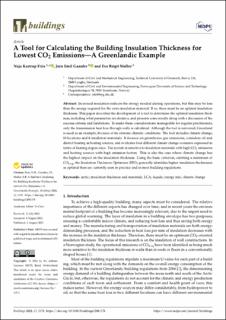| dc.description.abstract | Increased insulation reduces the energy needed during operations, but this may be less than the energy required for the extra insulation material. If so, there must be an optimal insulation thickness. This paper describes the development of a tool to determine the optimal insulation thickness, including what parameters are decisive, and presents some results along with a discussion of the success criteria and limitations. To make these considerations manageable for regular practitioners, only the transmission heat loss through walls is calculated. Although the tool is universal, Greenland is used as an example, because of its extreme climatic conditions. The tool includes climate change, 10 locations and 8 insulation materials. It focuses on greenhouse gas emissions, considers oil and district heating as heating sources, and evaluates four different climate change scenarios expressed in terms of heating degree days. The system is sensitive to insulation materials with high CO2 emissions and heating sources with high emission factors. This is also the case where climate change has the highest impact on the insulation thickness. Using the basic criterion, emitting a minimum of CO2-eq, the Insulation Thickness Optimizer (ITO), generally identifies higher insulation thicknesses as optimal than are currently seen in practice and in most building regulations. | en_US |

